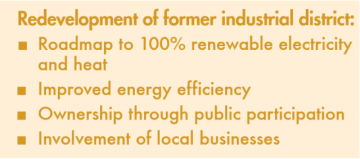Just recently, this blog reported on how Hamburg decided to remunicipalize its grid. Today, Fiona Woo reports on how Hamburg used an International Building Exhibition to sustainably redevelop former industrial neighborhoods.

Energy Hill Georgswerder, Hamburg-Wilhelmsburg (Photo by Reinhard Kraasch, CC BY-SA 3.0)
The districts of Wilhelmsburg and Veddel are located on the Elbe Islands in Hamburg, Germany and have historically been on the social outskirts of the city. Deciding that this formerly industrial area was ripe for redevelopment, the city framed its new urban development as an International Building Exhibition (IBA). IBA is a format of packaging urban planning initiatives that has been used throughout Germany in the past, most famously at Emscher Park in the Ruhr region.

The six-year IBA Hamburg project ran until 2013 and comprised over 60 sites and projects involving local enterprises and residents. The city’s overall goal was to use IBA Hamburg as an urban planning tool to generate new initiatives that would transform the area into a mixed-use space and integrate it into the rest of the city.
One priority of the project was to respond to the climate challenge, resulting in the formulation of urban sustainability goals that have a strong focus on energy efficiency and renewable energy. An overall target of the Renewable Wilhelmsburg concept was to supply the Elbe Islands with 100% renewable energy. In order to reach this target, the district of 50,000 inhabitants introduced high energy efficiency standards for new buildings, energy saving retrofits of old buildings, combined heat and power plants, and local renewable energy production. Following a step-by-step strategy, local renewable energy is expected to meet all electricity requirements of the Elbe Islands by 2025 and 85% of heating demands by 2050.
Integrating local companies and institutes that will continue their work in the long run after the IBA ended in 2013 was an important consideration. Getting partners like local energy supplier Hamburg Energie to invest in renewable energy projects was one of the steps taken to help ensure progress towards 100% renewable energy and other goals would continue.
IBA Hamburg tried to incorporate a high level of public participation by establishing platforms like the IBA Lab and IBA Forum, through which residents were given the chance to discuss specific topics with international experts. In the district ateliers, citizens elaborated concepts together with IBA staff. This participation process allowed Wilhelmsburg’s residents to feel greater ownership of the renewal of their district that helped mediate opposition to the development.
One well-known project was the transformation of a flak tower from the Second World War into a solar power plant as well as a biogas-fuelled central heat and power station that provide 800 local households with renewable electricity and heat. Renamed the Energiebunker, this former symbol of war has become a large and visible symbol of climate action.
IBA Hamburg formed a basis for Wilhelmsburg to reach its ambitious and necessary goal of 100% renewable energy supply. It demonstrates how a major project to redevelop an entire district in a regenerative way – by focusing on local and renewable resources – can be successfully accepted and implemented. It is an example of future just urban development that reduces the district’s dependence on its region by generating renewable energy locally.
Fiona Woo is Policy Officer for Climate and Energy at the World Future Council, where this text was first published. It is an excerpt from a report by the World Future Council called Regenerative Urban Development: A roadmap to the city we need.